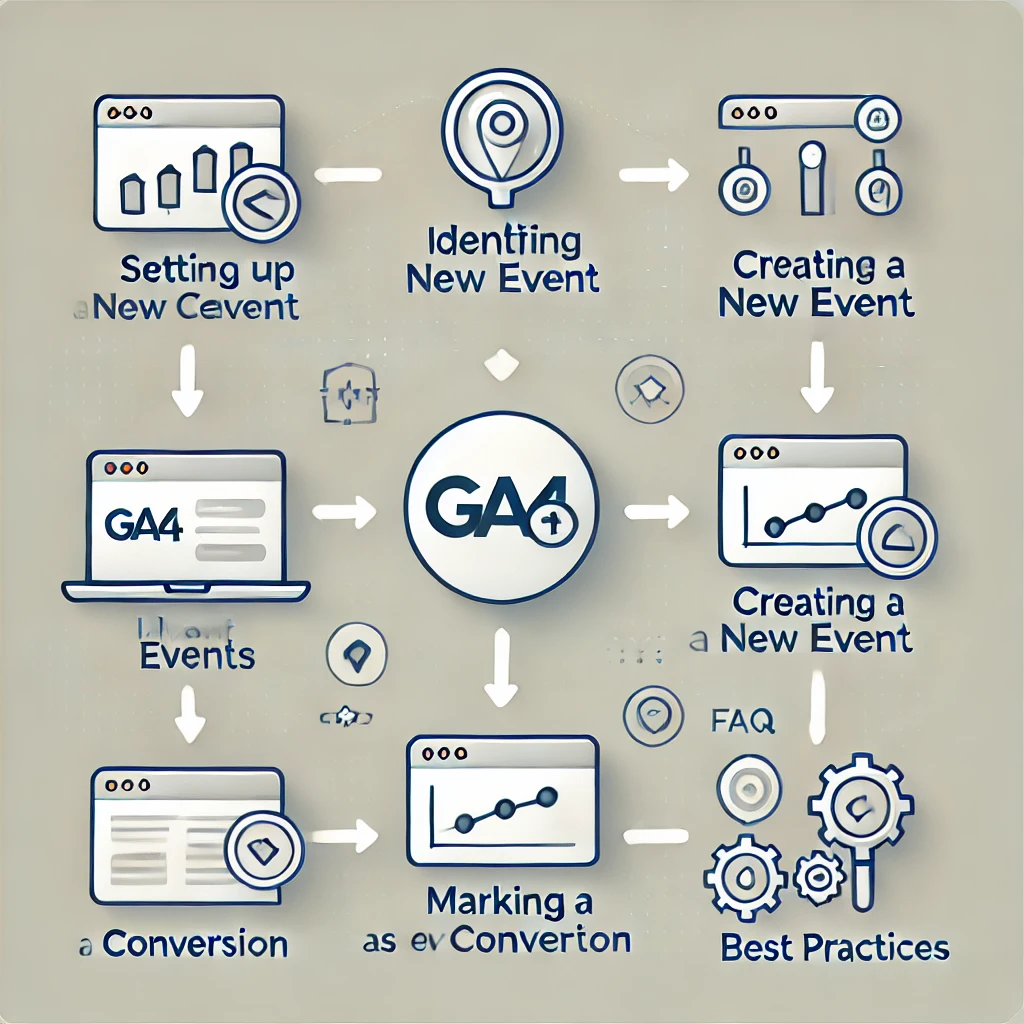Google Analytics 4 (GA4) brings a revamped approach to tracking user actions, replacing Universal Analytics (UA) with a more flexible, event-based model. In GA4, tracking conversions requires creating and configuring specific events as conversions, tailored to align with business goals. Whether it’s for a website or mobile app, setting up conversions in GA4 helps gauge customer engagement and optimize marketing strategies.
What is a Conversion in GA4?
In GA4, a conversion represents a valuable user action on your website or app. Unlike Universal Analytics, where conversions were tied to goals, GA4 uses events to track specific user interactions. A conversion event can include actions such as completing a purchase, signing up for a newsletter, or viewing a critical webpage.
Benefits of Conversion Tracking in GA4
- Improved Audience Insights: GA4’s event-based model provides a more granular understanding of user behavior, making it easier to see how users engage with various parts of your site or app.
- Cross-Platform Tracking: GA4’s flexible data model supports both web and mobile tracking within a single property, making conversion data cohesive across all user touchpoints.
- Enhanced Reporting: Conversion events in GA4 give you customized reports that inform your marketing and optimization strategies with precision.
Step-by-Step Guide to Setting Up Conversions in GA4
Step 1: Identify Important Events
- Define Objectives: Begin by identifying the actions that contribute most to your goals. These could include completed purchases, sign-ups, or visits to key pages.
- Event Structure: GA4 automatically tracks several events by default, such as
page_view,session_start, andfirst_visit. However, for more specific conversions, custom events are needed.
Step 2: Create a New Event in GA4
- Access Events: Log into your GA4 account and go to the property where you want to track conversions.
- Create Custom Event:
- Navigate to Admin > Events.
- Click Create Event, then Create under “Custom Event.”
- Define the event parameters by specifying the conditions. For example, if you want to track sign-ups, you might name the event “sign_up” and set conditions like
event_name=sign_up.
- Save the Event: After configuring, save the event.
Step 3: Mark the Event as a Conversion
- Conversions Section: Once your event is created, go to Admin > Conversions.
- Add New Conversion:
- Click New Conversion Event and enter the name of the custom event you just created (e.g., “sign_up”).
- Save your changes, and GA4 will start tracking this event as a conversion.
- Verify the Event: Head to Events to confirm that your new event is registered as a conversion. You should see it reflected in real-time or in the
Conversionsreport within 24 hours.
Read More: Why Google E-E-A-T Is Crucial for SEO?
Best Practices for Conversion Tracking in GA4
- Name Conversions Clearly: Use descriptive names for your conversions, such as “product_purchase” or “contact_form_submission,” to easily recognize them in reports.
- Avoid Duplicates: Be cautious when setting up similar events as conversions, as this can lead to duplicated data and inaccurate metrics.
- Event Parameters: Utilize parameters for more detailed data on conversions. For instance, add parameters like
valuefor purchase events to track revenue, ormethodto distinguish between signup methods. - Test Conversions: Before relying on your data, test all conversion setups to ensure they’re triggering correctly.
- Leverage Google Tag Manager (GTM): If you’re comfortable with GTM, use it to set up more complex events and trigger configurations seamlessly in GA4.
Troubleshooting Common Conversion Issues
- Delayed Tracking: Conversions may take up to 24 hours to appear in reports. If your conversions are not displaying immediately, check back later.
- Incorrect Event Parameters: Make sure event parameters align precisely with the conversion’s intended action. Any discrepancies can cause data inaccuracies.
- Verify Real-Time Data: Use the real-time view in GA4 to verify whether the conversion events are firing as expected during testing.
FAQs
1. What types of actions can I set as conversions in GA4?
GA4 allows you to set nearly any user interaction as a conversion, including purchases, sign-ups, downloads, form submissions, and content views. Custom conversions can be tailored to suit specific business objectives.
2. How many conversions can I track in GA4?
GA4 allows you to mark up to 30 events as conversions per property, which offers greater flexibility compared to Universal Analytics. However, it’s best to focus only on the most valuable events to avoid unnecessary complexity.
3. Can I edit or delete conversions in GA4?
Yes, you can edit conversions in the Admin > Events section by selecting or deselecting conversion status for specific events. Deleting conversions involves simply removing the mark as a conversion, which will stop GA4 from tracking it as such.
4. Do I need to use Google Tag Manager (GTM) for setting up conversions in GA4?
While GA4 allows for direct conversion tracking, GTM can be used for more advanced setups, especially when you want to track interactions that require complex trigger configurations. GTM offers additional control and flexibility for tracking conversions without needing direct coding.
5. How can I see my conversion data in GA4?
To view conversion data, go to Reports > Engagement > Conversions. This section gives insights into the performance of your marked conversions, including metrics like the total number of conversions, user engagement, and the source of conversions.
Conclusion
Setting up conversions in GA4 provides invaluable insights into user behavior and campaign effectiveness. By tracking meaningful actions, you gain a data-driven view of how well your website or app fulfills business goals. Implementing GA4 conversion tracking allows for a deeper understanding of customer journeys and helps optimize marketing efforts for higher ROI.






